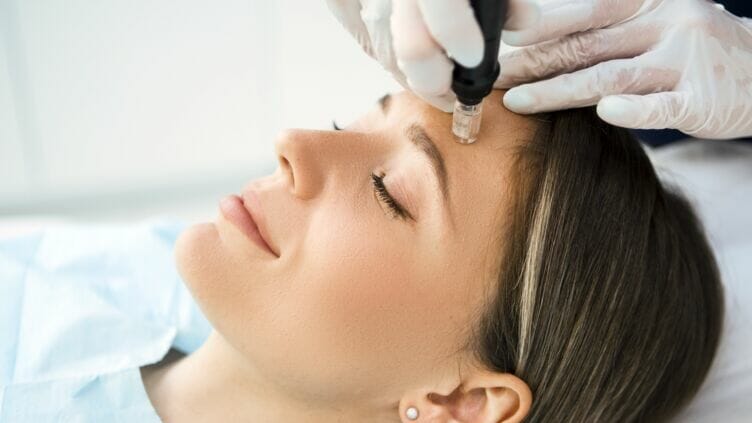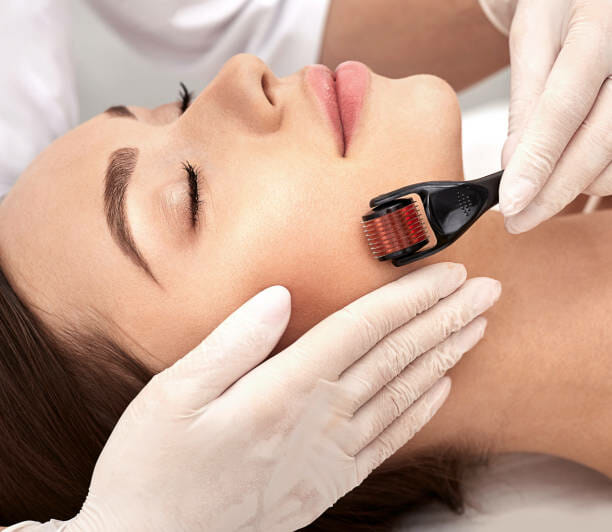How to Do Microneedling at Home

Photo Credit: Getty Stock
Microneedling is a trending beauty treatment that promises to make you look younger and healthier. You might have heard of microneedling and its many benefits, but you might not know that you can do it at home with a few easy-to-find supplies. Even if you don’t have the time or money to go to a salon, you can do microneedling at home with simple at-home microneedling tools.
Microneedling is a treatment that involves using tiny needles to puncture the skin. This treatment helps to improve the appearance of scars, stretch marks, and pores, as well as reduce wrinkles and lines. And the best part? You can do it at home for a fraction of the cost of going to a professional.
This post will discuss microneedling, its benefits, and how you can get started with your own home treatment. Keep reading to learn more about at-home microneedling and how you can get started today.
What is Microneedling?

Photo Credit: Getty Stock
When you stimulate collagen production, this technique encourages rejuvenation. The best way to boost collagen is through microneedling treatments. The top layer of the skin is punctured with tiny needles to tell the body to produce new collagen and elastin.
The two proteins collagen and elastin serve as the foundation for the general structure of the skin. As we age, collagen and elastin production begins to decline, and reduce fine lines, wrinkles, and sagging begin to show themselves.
You can improve the texture and general look of big pores by microneedling, which is why a board-certified dermatologist advises patients to try it. Additionally, it can help with scars. A derma roller performs microneedling on your entire face. The clusters of tiny needles that make up derma rollers pierce the skin when you roll it across the face.
While you may schedule a microneedling session in a specialist’s office, you can also practice the anti-aging method at home. A board-certified dermatologist advises carrying out the procedure once every two weeks using derma-rollers with needles no thicker than 0.3 mm.
The Difference Between At Home Microneedling and Office Microneedling

Photo Credit: Getty Stock
Faster dramatic results do not always imply a larger needle. Having patience is a virtue while microneedling. If control is an issue, you might want to consult a professional. The good news is that if an in-office procedure suits your budget, you can see the benefits sooner. Also, the process might be safer.
In-office treatment will give you better outcomes because they’ll probably use longer, sharper medical-grade needles. A succession of highly aggressive procedures can provide outcomes comparable to light or even deeper laser resurfacing procedures. Results usually become apparent between one and four sessions.
While you can use manual derma rollers for at-home treatments, in-office procedures frequently use an electric or battery-operated tool that might resemble a regular roller or pen. The key distinction between having the process done professionally by a dermatologist or esthetician against doing it yourself is that the latter will use longer needles that penetrate the skin far deeper to heal acne scars, wrinkles, and other issues.
Although at-home microneedling with a roller is ineffective for treating deep scars or wrinkles, it will unquestionably enhance texture and make those deep wrinkles or spots appear slightly less prominent.
At-home treatments can improve skin problems. They can enable the topical skincare products you use after microneedling to penetrate deeper for better effects since the needles penetrate just deeply enough to activate your skin’s epidermal growth factors and promote collagen production.
Benefits of Microneedling

Photo Credit: Getty Stock
Some dermatologists employ a technique called microneedling to treat various skin diseases. The method includes puncturing the skin with several tiny, sterilized needles to inflict physical harm.
The derma, a deeper and outermost layer of skin, regenerates due to this damage. You can also use at-home microneedling devices if you want to do it yourself. You can heal numerous skin-related ailments by microneedling, including:
- Wrinkles
- Scarring
- Acne
- Alopecia
- Problems with skin complexion
- Skin marks
- Rosacea
- Following liposuction or weight reduction, for example, loose skin
- Skincare and skin rejuvenation
Professionals can also employ microneedling to penetrate the skin with medications like topical tretinoin or vitamin C. This treatment can improve the management of several conditions.
How to Start Microneedling At Home
Select your derma roller to begin. According to research, some people may be able to see noticeable skin changes with 1.5 millimeters (mm) needles after two to three sessions. However, you can see these procedures in an office setting. It would be best to start tiny, usually less than .15 mm.
Things to Consider When Buying a Derma Roller
It’s crucial to remember that derma rollers have a range of needle sizes available. Making the correct choice will significantly impact your experience and outcomes. Here are the skin conditions and the needle depth you need:
Scars and Acne scars
Rollers are beneficial for those with scars since they speed up the skin’s natural repair processes and allow your skin to heal. A derma roller with a 0.75–1mm needle length would be best for active acne scars.
1.5mm would be ideal for deeper scars. Depending on how shallow the scar is, you can use larger-sized rollers with longer needles, such as one that is 1.5mm and above needle depth, for dark spots that are not on the face.
Wrinkles and Fine Lines
Derma rollers are excellent for fine lines and wrinkles and are frequently used to improve elasticity, minimize the appearance of wrinkles, and assist with discoloration. Depending on your needs, you can begin with a 0.5mm needle size and use it once or twice weekly.
Hyperpigmentation
Derma rollers are excellent for reducing hyperpigmentation by dispersing melanin clumps, which will solve the issue. Additionally, it facilitates the skin-lightening cream’s absorption, which speeds up outcomes even more. You can use any size of 0.5mm or fewer needles for this skin condition.
Stretch Marks
A larger needle is needed to treat this since there are deep skin scars. The dermal layers of the skin should be allowed to thicken with a 1.5mm–2.0mm roller, which will assist the marks in gradually disappearing and will replace them with healthy, smooth skin.
Please remember that consistent, prolonged application is required to remove these markings entirely.
Hair Loss
You can use a 0.5 to 1.0mm roller to encourage the synthesis of endothelial growth factors for follicle and hair development. You can apply a 0.5mm derma roller once a week or once a month. Contrarily, you can use 0.75 to 1.0mm one time per month. If you’re buying a derma roller for the first time, we advise choosing the 0.5mm size.
Enlarged Pores
Dermarolling produces new collagen, which plumps and tightens the look of the enlarged pore and efficiently reduces its size. This technique is beneficial in reducing enlarged pores.
By utilizing a derma roller with fine needles no more significant than 0.5mm, you can minimize the size of the pores. You should pick a size depending on your preferences and how frequently you want to use it.
5 Steps to Microneedling At Home

Photo Credit: Getty Stock
When microneedling at home, safety should be your top priority because needles are involved. To reduce the risk of infection, patients who intend to do treatments at home must thoroughly clean the skin and sterilize their microneedling equipment.
Additionally, they need to be careful not to press too firmly on the needling tool because doing so might leave scars. In-office and at-home procedures sometimes have allergic reactions to items used following needling. Here are the at-home microneedling devices you need:
- a derma roller
- 70 percent isopropyl rubbing alcohol
- cleanser
- a numbing cream (optional)
- Follow-up right serums
Here’s the five-step method:
1. Get your derma roller clean.
Always begin by cleaning your derma roller by soaking it for 5 to 10 minutes in 70% isopropyl alcohol before using it.
2. Clean your face.
Cleanse your skin once with a mild pH-balanced cleanser, then do it once more. Before you start rolling, you should also lightly rub the 70% isopropyl alcohol over your face. Consider using a numbing lotion after washing your face if you are pain-sensitive. If your therapy has progressed to utilize longer needles, you’ll want to apply one immediately.
If necessary, apply a numbing cream. It varies depending on how deeply and sharply the needles are inserted. It may be moderately unpleasant. Before the treatment, you might use a topical numbing lotion for 30 minutes. Following the surgery, you can have localized bleeding.
3. Begin rolling.
Divide your face into four areas before you begin, avoiding the eye area entirely:
- Upper left
- Top right
- Lower left
- Lower right
Roll the derma roller over a single area two to three times in a single direction. You can roll your skin vertically or horizontally, being sure to raise it between rolls. Assuming you begin vertically after covering a part in this manner twice or three times.
Adjust the roller a little and continue until you have completed the entire piece in that direction. Repeat the whole process in that spot once more, but this time roll horizontally and use a cross-hatch pattern.
4. Wash your face.
Once you’ve finished rolling, rinse your face with fresh water and use a clean pad to pat it dry.
5. Clean your derma roller.
Initially, use dishwashing soap to clean the derma roller. After another 10-minute soak in the 70% isopropyl alcohol, place it back in its plastic case.
Don’t wait too long to change your derma roller – you should discard your existing roller for a fresh one after ten to fifteen uses, so you could need a new one every month if you’re rolling multiple days a week.
How Often To Use Microneedling At Home?
Depending on the size of the microneedle, usage frequency varies. You can administer the therapy more often if the needle is smaller. Consider adding additional skin care procedures between your microneedling sessions if you genuinely want to boost your results.
- 0.20 – 0.30mm: You can use it daily or every second day on the same skin area.
- 0.5mm: You can use it weekly on the same skin area.
- 0.75-1.00mm: You can use it every four to six weeks.
- 1.5mm: You may use it once every six to eight weeks on the same skin area.
- 2.0-3.0mm: Use it once every eight weeks on the same skin area.
- 2.0+ mm long needles: Utilize it on thicker skin like thighs, feet, back, arms, or back of the hands. Please do not use it on the face. Professional supervision is also highly suggested for the use of thicker needles.
Do the tiny needles hurt and make me bleed?
Depending on the size of your derma roller, bleeding may or may not occur. No bleeding will happen if you use a 0.20-0.3mm derma roller, and there won’t be any discomfort. You should select your roller based on your requirements and the severity of your skin issue.
You can use 0.20 to 0.3mm sizes daily to improve topical product absorption because they cannot promote collagen synthesis. For moderate-deep scarring, wrinkles, and other issues, you can use diameters between 0.5 and 1.0mm. If you are unsure which roller size to use, we advise beginning with 0.5mm since, while requiring more treatments, it can yield outcomes comparable to those of 1.0mm.
Some people think that bleeding more will produce better outcomes. This misconception is untrue, though. Bleeding is not necessary for sizes between 0.20 and 0.3mm. Unless you roll your skin regularly and vigorously, bleeding for 0.5 to 1.0mm will be modest to mild. For diameters 1.5mm and above, numbing cream will be necessary since they are more unpleasant and may cause more bleeding.
Rolling in places with a greater fat concentration is not advisable. For instance, if you roll the marks away, you should only see some localized redness. Avoid rolling for longer than is advised, as this might prolong swelling, redness, and healing.
Conclusion

Photo Credit: Getty Stock
Not everyone loves needles, but tiny punctures are just a little compared to the benefits of microneedling. If you have sensitive skin and have an adverse reaction to treatment, it is best to consult a dermatologist before purchasing any microneedling device. Activate your skin’s epidermal growth factors and promote collagen production through microneedling.
And, because this is a controlled skin injury, it won’t cause any adverse reactions that are sometimes associated with aggressive treatment. So why not give microneedling treatment a try? This treatment is your best bet for skincare, and we think you’ll be pleasantly pleased by the outcomes. Have you tried microneedling at home? Let us know in the comments below!

